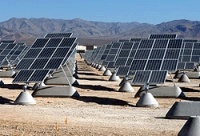US scientists develop self-cleaning solar panels
Scientists in the US have developed self-cleaning solar panels based on technology developed for space missions to Mars.
In a report at the 240th National Meeting of the American Chemical Society (ACS), they described how a self-cleaning coating on the surface of solar cells could increase the efficiency of producing electricity from sunlight and reduce maintenance costs for large-scale solar installations.
‘We think our self-cleaning panels used in areas of high dust and particulate pollutant concentrations will highly benefit the systems’ solar energy output,’ said study leader Malay K Mazumder, Ph.D. ‘Our technology can be used in both small- and large-scale photovoltaic systems. To our knowledge, this is the only technology for automatic dust cleaning that doesn’t require water or mechanical movement.’

Mazumder, who is with Boston University, said that the need for this technology is growing with the popularity of solar energy. The use of solar, or photovoltaic, panels is said to have increased by 50 per cent from 2003 to 2008 and forecasts suggest a growth rate of at least 25 per cent annually.
Register now to continue reading
Thanks for visiting The Engineer. You’ve now reached your monthly limit of news stories. Register for free to unlock unlimited access to all of our news coverage, as well as premium content including opinion, in-depth features and special reports.
Benefits of registering
-
In-depth insights and coverage of key emerging trends
-
Unrestricted access to special reports throughout the year
-
Daily technology news delivered straight to your inbox










Water Sector Talent Exodus Could Cripple The Sector
Maybe if things are essential for the running of a country and we want to pay a fair price we should be running these utilities on a not for profit...